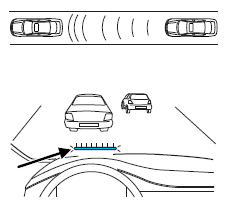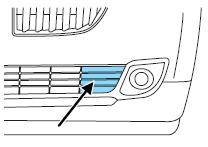Collision warning system (if equipped)

The collision warning with brake support, is designed to alert the driver of certain collision risks with a red warning light located above the dashboard and an audible warning chime. The brake support assists the driver in reducing the collision speed, by pre-charging the brakes.
WARNING: This system is designed to be a supplementary driving aid. It is not intended to replace the driver’s attention, and judgment, or the need to apply the brakes. This system does NOT activate the brakes automatically. Failure to press the brake pedal to activate the brakes may result in a collision.
WARNING: The collision warning system with brake support cannot help prevent all collisions. Do not rely on this system to replace driver judgment and the need to maintain distance and speed.
Note: The collision warning with brake support will not detect, warn, or respond to potential collisions with vehicles to the rear or sides of the vehicle.
Operation
The radar sensor detects vehicles ahead that are moving in the same direction as your vehicle.
If the radar detects that your vehicle is rapidly closing in on another vehicle, a red warning light will illuminate and an audible warning chime will sound.
After that, if the risk of collision further increases after the warning light, the brake support prepares the brake system for rapid braking.
This may be apparent to the driver.
However, the system will not automatically activate the brakes.
The vehicle will not stop unless the driver presses the brake pedal. If the brake pedal is pressed then braking is implemented with full brake function, even if the force on the brake pedal is light.
The collision warning system is active at speeds above approximately 5 mph (8 km/h).

Collision warning system limitations
Due to the nature of radar technology, there may be certain instances where vehicles will not provide a collision warning. These include:
• Stationary or slow moving vehicles below 6 mph (10 km/h).
• Pedestrians or objects in the roadway.
• Oncoming vehicles in the same lane.
• Severe weather conditions (see also blocked sensor section).
• Debris build-up on the grille near the headlamps (see block sensor
section).
• Small distance to vehicle ahead.
• Steering wheel and pedal movements are large (very active driving
style).
• High interior temperatures, which may deactivate the illumination or
the warning lamps until the interior temperature reduces (audible
warning will alert the driver).
In addition, sun load and sunglasses may reduce the visibility of the warning lamps. Therefore, it is recommended to keep the audible warning on.
If the front end of the vehicle is hit or damaged, the radar sensing zone may be altered causing missed or false collision warnings. Check with your authorized dealer to have your collision warning radar checked for proper coverage and operation.
WARNING: The collision warning system’s brake support can only help reduce the speed at which a collision occurs if the driver applies the vehicle’s brakes. The brake pedal must be pressed just like any typical braking situation.
Blocked sensor

If a message regarding a blocked sensor is displayed, the radar signals from the sensor, located behind a fascia cover near the driver side of the lower grille, have been obstructed. When the radar signals are obstructed, a vehicle ahead cannot be detected and the collision warning system will not function.
The following table lists possible causes and actions for this message being displayed.

Activating/deactivating collision warning system
To turn the warning system and/or chime on or off and set the warning sensitivity <– –>, refer to Message center in the Instrument Cluster chapter.
Note: If the system cannot be turned off in a MyKey equipped vehicle, refer to MyKey in the Locks and Security chapter for more information.
Note: If collision warnings are perceived as being too frequent or disturbing then the warning sensitivity can be reduced, though the manufacturer recommends using the highest sensitivity setting where possible. Setting lower sensitivity would lead to fewer and later system warnings. Refer to the Message center in the Instrument Cluster chapter for instructions on reducing the sensitivity.
See also:
Ford and Lincoln car care products
Your Ford or Lincoln authorized dealer has many quality products
available to clean your vehicle and protect its finishes. These quality
products have been specifically engineered to fulfill your ...
Driving on hilly or sloping terrain
Although natural obstacles may make it necessary to travel diagonally up
or down a hill or steep incline, you should always try to drive straight up
or straight down. Avoid driving crosswise or tu ...
Replacing supplemental park bulbs
1. Make sure the headlamp switch is in the off position, then open the
hood.
2. At the wheel well, remove the
press pins from the splash shield,
then pull the splash shield back to
gain a ...
